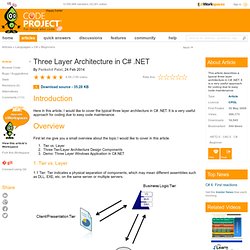

Application Archetypes. C.B.R. Download latest version (external link) Introduction With the "success" of the first project and some spare time, I start a completely new version hosted on the same CodePlex project.

I decided to rewrite it to explore a bit more about the MVVM pattern and extend it to other ebook formats. I am also interested in 7 phone development, so I took the idea of dynamic books that I have seen on an iPhone application. The roadmap includes: Better user interface and design: Ribbon...Multiple format support and conversion: Images, PDF, XPS, CBR/RAR, CBZ/ZIP, ePUB...Dynamic books format: CBZD, a complete zip format with additional XML files associated to pages that contain frame descriptions. Related publications: CodePlex, "Product" site, Blog Screenshot: New C.B.R. interface Project Content As a developer, what you can find helpful in this project, despite a lot of tricks that are not described here: Chapters Screenshots You can find more screenshots on the product web site : Model Core Classes View Layer.
Three Layer Architecture in C# .NET. Download source - 35.28 KB Introduction Here in this article, I would like to cover the typical three layer architecture in C# .NET.

It is a very useful approach for coding due to easy code maintenance. Overview First let me give you a small overview about the topic I would like to cover in this article. Tier vs. 1. 1.1 Tier: Tier indicates a physical separation of components, which may mean different assemblies such as DLL, EXE, etc. on the same server or multiple servers. As you can see in the above figure, Data Tier have no direction with Presentation Tier, but there is an intermediate Tier called Business Tier which is mainly responsible to pass the data from Data Tier to Presentation Tier and to add defined business logic to Data.
Design Fundamentals. For more details of the topics covered in this guide, see Contents of the Guide.

This section of the guide contains a series of topics that will help you to understand the fundamentals of layered architecture, and provide practical guidance for some of the typical layers used by most applications, such as presentation, business, data, and service layers. This section contains the following chapters: Typically, each layer will contain of number of components. As you design the components in each layer, you must consider a range of factors that will affect the overall success of your design. This section of the guide contains guidance to help you design your components to avoid the commonly found issues, and to follow best practice.
The overall quality and the subsequent success and of your application design depends on how well it addresses a range of quality attributes such as security, reusability, performance, and maintainability.
MVVM Light Toolkit. MEF in .NET 4.5. Download MEF2 Example - 13.4 KB Introduction This article explains the problems with MEF1 and improvements in MEF2 (in .NET 4.5).

Attached is a Visual Studio solution built in .NET 4.5. Read the following articles for more on MEF: The primary focus of MEF1 was extensibility, MEF allows to create an application such that application's different parts can be extended like a plug-in. MEF1 has some problems... There was no way exporting types without giving them export attribute. MEF2 has solved the above problems: Attribute-less registration: One new class RegistrationBuilder is introduced that handles part creation and export registration automatically, it has solved both problems arising because the export attribute is required for type registration.RegistrationBuilder introduced three For*() methods as below that can identify/select parts to export.ForType(): selects a single type.